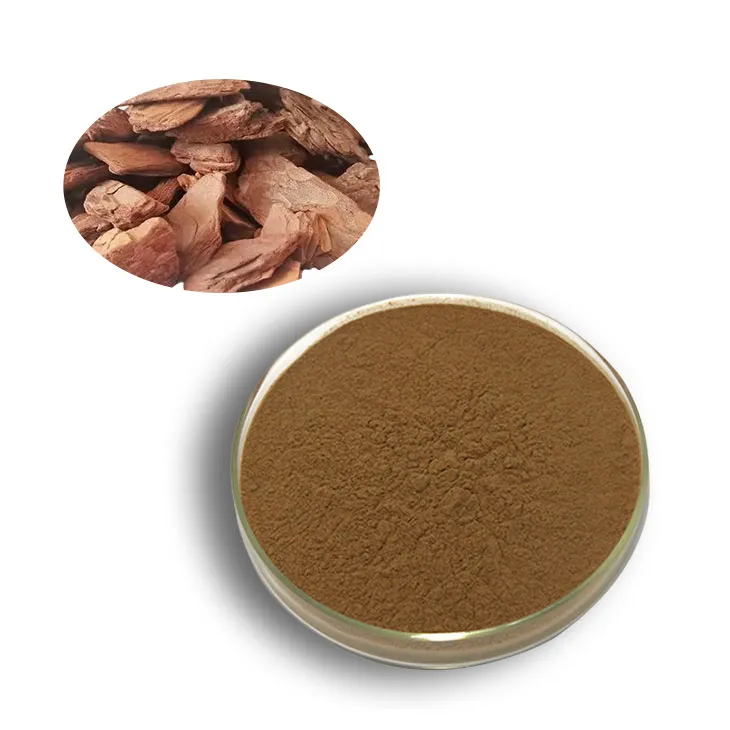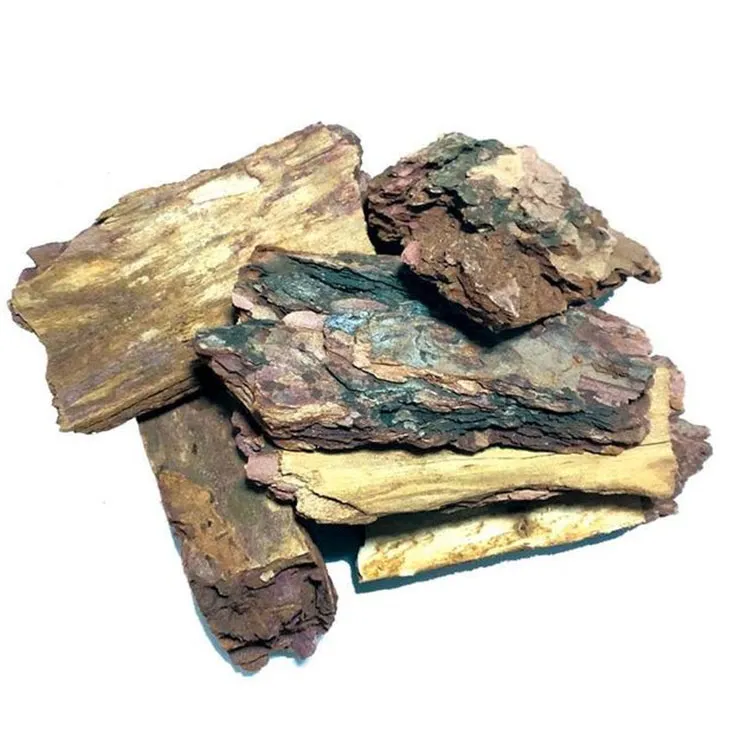- 0086-571-85302990
- sales@greenskybio.com
Pine Bark Extract Powder: Uses, Advantages and Manufacturing Processes.
2024-11-12

1. Introduction
Pine bark Extract Powder has emerged as a significant substance with a wide range of applications in multiple industries. It is derived from the bark of pine trees, which are abundant in nature. This natural origin not only makes it an attractive option but also offers several benefits that are being increasingly recognized and exploited in today's market.

2. Uses of Pine bark Extract Powder
2.1 Medical Applications
In the medical field, Pine bark Extract Powder shows great potential. Its anti - inflammatory and antioxidant capabilities are of particular interest. Chronic diseases such as cardiovascular diseases, diabetes, and some neurodegenerative disorders are often associated with inflammation and oxidative stress. The anti - inflammatory properties of pine bark extract powder can help to reduce inflammation in the body. For example, it may inhibit the production of pro - inflammatory cytokines, which are molecules that play a key role in the inflammatory response.
The antioxidant activity is also crucial. Free radicals are highly reactive molecules that can cause cell damage. Pine bark extract powder, rich in phenolic compounds, can scavenge these free radicals, thereby protecting cells from damage. This may contribute to the prevention and management of various diseases. Some studies have suggested that it may improve endothelial function in blood vessels, which is important for cardiovascular health.
2.2 Food Industry Applications
In the food industry, pine bark extract powder has found multiple uses. It can be used as a natural preservative. In an era where consumers are increasingly demanding clean - label products, natural preservatives are highly sought after. Pine bark extract powder can inhibit the growth of spoilage microorganisms such as bacteria and fungi, thereby extending the shelf life of food products.
It can also be added to functional foods. Functional foods are those that provide additional health benefits beyond basic nutrition. By adding pine bark extract powder to products such as energy bars, cereals, or beverages, manufacturers can enhance the antioxidant content of these products. This can attract health - conscious consumers who are looking for products that can help them maintain good health.

3. Advantages of Pine Bark Extract Powder
3.1 Rich in Phenolic Compounds
One of the major advantages of pine bark extract powder is its richness in phenolic compounds. These compounds are well - known for their antioxidant properties. They can donate electrons to free radicals, thereby neutralizing them and preventing oxidative damage. The phenolic compounds in pine bark extract powder include flavonoids, phenolic acids, and stilbenes. Flavonoids, for example, have been shown to have various health - promoting effects, such as reducing inflammation, improving blood circulation, and protecting against certain cancers.
3.2 Prevention of Cell Damage
As mentioned earlier, the antioxidant activity of pine bark extract powder helps in the prevention of cell damage. Free radicals are constantly generated in the body through normal metabolic processes as well as exposure to environmental factors such as pollution, radiation, and cigarette smoke. If not neutralized, these free radicals can react with cellular components such as DNA, proteins, and lipids, leading to cell damage. By scavenging free radicals, pine bark extract powder can help to maintain the integrity of cells and prevent the development of various diseases associated with oxidative stress.
3.3 Sustainability
The sustainability of pine bark extract powder is another important advantage. Pine trees are widely distributed around the world and are a renewable resource. The extraction of pine bark for the production of extract powder can be carried out in a sustainable manner. For example, proper forestry management practices can ensure that pine trees are harvested in an environmentally friendly way, and the bark is removed without causing harm to the tree. This makes pine bark extract powder an environmentally friendly option compared to some synthetic alternatives.

4. Manufacturing Processes of Pine Bark Extract Powder
4.1 Raw Material Selection
The first step in the manufacturing process is the careful selection of raw materials. Only high - quality pine bark should be used. The pine bark should be sourced from healthy pine trees, preferably from sustainable forests. Factors such as the age of the tree, the part of the bark used, and the season of collection can affect the quality of the extract. For example, younger trees may have bark with different chemical compositions compared to older trees. The bark from the trunk may also have different properties compared to that from the branches.
4.2 Extraction Techniques
After the raw material is selected, extraction techniques are employed to obtain the valuable components from the pine bark. There are two main types of extraction techniques: mechanical and chemical.
- Mechanical Extraction: This involves physical methods to break down the pine bark and release the active components. One common mechanical method is grinding. The pine bark is ground into a fine powder, which increases the surface area available for extraction. Another method is pressing, where the bark is subjected to pressure to squeeze out the extract. However, mechanical extraction may not be as efficient as chemical extraction in obtaining all the desired components.
- Chemical Extraction: Chemical extraction uses solvents to dissolve the active components from the pine bark. Commonly used solvents include water, ethanol, and ethyl acetate. The choice of solvent depends on the solubility of the target components. For example, some phenolic compounds are more soluble in ethanol than in water. The pine bark is soaked in the solvent for a certain period, and then the solvent containing the dissolved components is separated from the solid residue. Chemical extraction can be more effective in extracting a wide range of components, but it requires careful handling of solvents to ensure safety and environmental compliance.
4.3 Concentration and Drying
Once the extract is obtained, it is usually in a liquid form. The next step is concentration and drying to form the powder. Concentration involves removing the excess solvent from the extract. This can be done through evaporation techniques such as vacuum evaporation or heat evaporation. Vacuum evaporation is often preferred as it can be carried out at lower temperatures, which helps to preserve the integrity of the active components.
After concentration, the extract is dried to form a powder. Drying methods include spray drying, freeze - drying, and oven drying. Spray drying is a popular method in the industry as it can produce a fine powder with good flowability. Freeze - drying can preserve the structure and activity of the components better but is more expensive. Oven drying is a simple and cost - effective method but may require careful control of temperature to avoid overheating and degradation of the components.
4.4 Quality Control
Throughout the manufacturing process, quality control measures are crucial. Quality control starts from the raw material selection stage, where the pine bark is inspected for quality and purity. During the extraction process, the parameters such as extraction time, temperature, and solvent concentration are carefully monitored to ensure consistent extraction efficiency.
After the powder is formed, various tests are carried out to determine its quality. These tests include analysis of the chemical composition, determination of antioxidant activity, and microbiological testing. The chemical composition analysis can be done using techniques such as high - performance liquid chromatography (HPLC) to identify and quantify the phenolic compounds present in the powder. Antioxidant activity can be measured using assays such as the DPPH (2,2 - diphenyl - 1 - picrylhydrazyl) assay. Microbiological testing ensures that the powder is free from harmful microorganisms such as bacteria, yeast, and molds.
5. Conclusion
Pine bark extract powder has a wide range of uses and numerous advantages. Its applications in the medical and food industries are promising, and its manufacturing process can be carried out in a way that ensures quality and sustainability. As research continues to uncover more about its properties and potential applications, it is likely that pine bark extract powder will become even more important in the future. However, it is also important to ensure that proper quality control measures are in place throughout its production and use to fully realize its benefits.
FAQ:
What are the main uses of pine bark extract powder in the medical field?
It shows potential in treating certain chronic diseases in the medical field because of its anti - inflammatory and antioxidant capabilities.
How can pine bark extract powder be used in the food industry?
In the food industry, it can be used as a natural preservative or added to functional foods.
What makes pine bark extract powder have strong antioxidant activity?
It is rich in phenolic compounds, which endow it with strong antioxidant activity.
Why is pine bark extract powder considered sustainable?
It is considered sustainable because pine trees are widely available.
What are the key steps in the manufacturing process of pine bark extract powder?
The key steps include carefully selecting the raw material - pine bark, then using mechanical or chemical extraction techniques to extract valuable components. After that, the extracted liquid is concentrated and dried to form the powder. Throughout the process, quality control measures are crucial to ensure the purity and efficacy of the final product.
Related literature
- Antioxidant Activity of Pine Bark Extract: A Review"
- "The Use of Pine Bark Extract in Functional Foods: Current Trends and Future Prospects"
- "Manufacturing Processes of Plant Extract Powders: The Case of Pine Bark Extract"
- ▶ Hesperidin
- ▶ Citrus Bioflavonoids
- ▶ Plant Extract
- ▶ lycopene
- ▶ Diosmin
- ▶ Grape seed extract
- ▶ Sea buckthorn Juice Powder
- ▶ Fruit Juice Powder
- ▶ Hops Extract
- ▶ Artichoke Extract
- ▶ Mushroom extract
- ▶ Astaxanthin
- ▶ Green Tea Extract
- ▶ Curcumin
- ▶ Horse Chestnut Extract
- ▶ Other Product
- ▶ Boswellia Serrata Extract
- ▶ Resveratrol
- ▶ Marigold Extract
- ▶ Grape Leaf Extract
- ▶ New Product
- ▶ Aminolevulinic acid
- ▶ Cranberry Extract
- ▶ Red Yeast Rice
- ▶ Red Wine Extract
-
Eyebright Extract
2024-11-12
-
Curcumin
2024-11-12
-
Mangosteen extract powder
2024-11-12
-
Nutmeg Extract
2024-11-12
-
Phyllanthus Emblica Extract
2024-11-12
-
Calendula Extract
2024-11-12
-
Sophora Japonica Flower Extract
2024-11-12
-
Cocoa Extract
2024-11-12
-
Acerola Juice Powder
2024-11-12
-
Peppermint Extract Powder
2024-11-12





















